Section 1.1 Section 1.2 Section 1.3 - The Student Room
Section 1.1 Section 1.2 Section 1.3 - The Student Room
Section 1.1 Section 1.2 Section 1.3 - The Student Room
Create successful ePaper yourself
Turn your PDF publications into a flip-book with our unique Google optimized e-Paper software.
SECTION 8<br />
<strong>Section</strong> 8.2<br />
1 a [H + (aq)] = 1 ¥ 10 –2 mol dm –3 ; therefore pH = 2<br />
b [H + (aq)] = 2 ¥ 10 –1 mol dm –3 ; therefore pH = 0.7<br />
c [H + (aq)] = 4 ¥ 10 –1 mol dm –3 ; therefore pH = 0.4<br />
d [H + (aq)] = 4 ¥ 10 –1 mol dm –3 ; therefore pH = 0.4<br />
[H + (aq)] 2<br />
2 a 1.7 ¥ 10 –5 =<br />
1 ¥ 10 –1<br />
[H + (aq)] 2 = 1.7 ¥ 10 –6 mol 2 dm –6<br />
[H + (aq)] = <strong>1.3</strong> ¥ 10 –3 mol dm –3<br />
pH = 2.9<br />
[H + (aq)] 2<br />
b 1.7 ¥ 10 –5 =<br />
5 ¥ 10 –2<br />
[H + (aq)] 2 = 8.5 ¥ 10 –7 mol 2 dm –6<br />
[H + (aq)] = 9.2 ¥ 10 –4 mol dm –3<br />
pH = 3.0<br />
[H + (aq)] 2<br />
c 6.3 ¥ 10 –5 =<br />
1 ¥ 10 –3<br />
[H + (aq)] 2 = 6.3 ¥ 10 –8 mol 2 dm –6<br />
[H + (aq)] = 2.5 ¥ 10 –4 mol dm –3<br />
pH = 3.6<br />
[H + (aq)] 2<br />
d 1.6 ¥ 10 –4 =<br />
2.5<br />
[H + (aq)] 2 = 4.0 ¥ 10 –4 mol 2 dm –6<br />
[H + (aq)] = 2.0 ¥ 10 –2 mol dm –3<br />
pH = 1.7<br />
3 a <strong>The</strong> reaction of the acid with water goes to<br />
completion.<br />
b [H + (aq)] = [A – (aq)]<br />
[HA(aq)] at equilibrium = original [HA(aq)].<br />
4 a Strong acid – hydrochloric acid<br />
Weak acid – nitrous acid (nitric(III) acid)<br />
5<br />
b <strong>The</strong> position of the equilibrium for the reaction of the<br />
strong acid with water is completely to the right:<br />
HCl(aq) + H 2<br />
O(l) Æ Cl – (aq ) + H 3<br />
O + (aq)<br />
<strong>The</strong> amount in moles of H + (aq) ions is equal to the<br />
amount in moles of HCl put into solution. Thus,<br />
[H + (aq)] = 0.01 mol dm –3 and pH = 2.<br />
<strong>The</strong> position of the equilibrium for the reaction of the<br />
weak acid with water is more to the left:<br />
HNO 2<br />
(aq) + H 2<br />
O(l) D NO 2 – (aq) + H 3<br />
O + (aq)<br />
<strong>The</strong> amount in moles of H + (aq) ions is very much less<br />
than the amount in moles of HNO 2<br />
put into solution.<br />
To obtain a solution with pH = 2, the nitrous acid<br />
solution must be more concentrated than the<br />
hydrochloric acid solution.<br />
a<br />
b<br />
c<br />
[OH – (aq)]/mol dm –3 [H + (aq)]/mol dm –3 pH<br />
1 1 ¥ 10 –14 14<br />
0.01 1 ¥ 10 –12 12<br />
0.2 5 ¥ 10 –14 13.3<br />
6 a In alkaline solution, the equilibrium shifts to the right<br />
as H + (aq) is removed by reaction with OH – (aq), so the<br />
indicator will be present as the pink In – form.<br />
b K a<br />
= [H+ (aq)][In – (aq)]<br />
[HIn(aq)]<br />
c K a<br />
= 5.01 ¥ 10 –10 mol dm –3<br />
= [H+ (aq)][In – (aq)]<br />
[HIn(aq)]<br />
At the end point [HIn(aq)] = [In – (aq)]<br />
Hence 5.01 ¥ 10 –10 mol dm –3 = [H + (aq)]<br />
pH at end point = 9.3<br />
7 a i K a<br />
= 5.0 ¥ 10 –10 mol dm –3 , pK a<br />
= 9.3<br />
ii K a<br />
= <strong>1.3</strong> ¥ 10 –10 mol dm –3 , pK a<br />
= 9.9<br />
iii K a<br />
= 4.8 ¥ 10 –4 mol dm –3 , pK a<br />
= 3.3<br />
b HF, HCN, phenol<br />
<strong>Section</strong> 8.3<br />
1 a 1.6 ¥ 10 –4 mol dm –3 = [H + 0.1 mol dm–3<br />
f In 750 cm<br />
(aq)] ¥ 3 of solution the concentrations of acid and<br />
0.1 mol dm –3<br />
salt are<br />
<strong>The</strong>refore [H + (aq)] = 1.6 ¥ 10 –4 mol dm –3<br />
0.1 ¥ 250<br />
pH = 3.8<br />
[acid] = mol dm<br />
750<br />
–3<br />
b 6.3 ¥ 10 –5 mol dm –3 = [H + 0.03 mol dm–3<br />
(aq)] ¥<br />
0.01 mol dm –3<br />
0.1 ¥ 500<br />
<strong>The</strong>refore [H + (aq)] = 2.1 ¥ 10 –5 mol dm –3<br />
[salt] = mol dm –3<br />
750<br />
pH = 4.7<br />
0.1 ¥ 500 mol dm –3<br />
c <strong>The</strong> concentrations of acid and salt in the mixture will<br />
1.7 ¥ 10 –5 mol dm 3 = [H + (aq)] ¥<br />
0.1 ¥ 250 moldm –3<br />
both be 0.05 mol dm –3 . This is equivalent to diluting<br />
the buffer in 1 a with an equal volume of water. <strong>The</strong><br />
[H + (aq)] = 8.5 ¥ 10 –6 mol dm –3<br />
pH remains unchanged at 3.8.<br />
pH = 5.1<br />
d <strong>1.3</strong> ¥ 10 –5 mol dm –3 = [H + (aq)] ¥ 5.0 ¥ 10–3 mol dm –3<br />
1 ¥ 10 –1 mol dm –3<br />
g 1.7 ¥ 10 –5 mol dm –3 = [H + 0.1 mol dm –3<br />
(aq)] ¥<br />
<strong>The</strong>refore [H + (aq)] = 2.6 ¥ 10 –4 mol dm –3<br />
0.2 mol dm –3<br />
pH = 3.6<br />
[H + (aq)] = 3.4 ¥ 10 –5 mol dm –3<br />
2 ¥ 1.5 ¥ 10 –2 mol dm –3<br />
e 1.6 ¥ 10 –4 mol dm –3 = [H + pH = 4.5<br />
(aq)] ¥<br />
2 ¥ 5 ¥ 10 –3 mol dm –3 <strong>The</strong> pH of the buffer solution, on adding a higher<br />
[H + (aq)] = 5.3 ¥ 10 –5 mol dm –3<br />
proportion of acid, has decreased. Changing the ratio<br />
pH = 4.3<br />
of [salt] : [acid] provides a way of ‘fine tuning’ the pH<br />
of a buffer solution.<br />
185


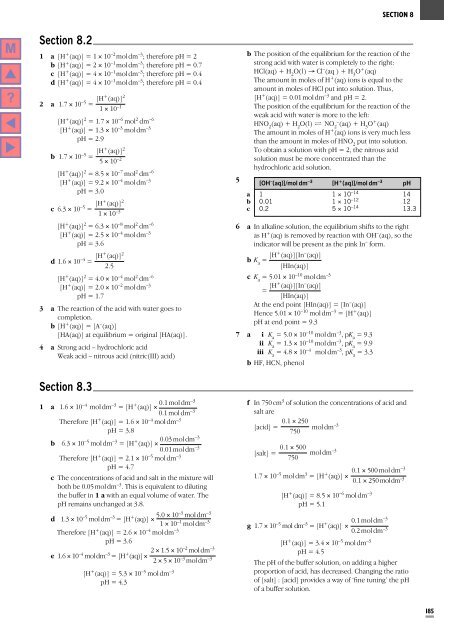
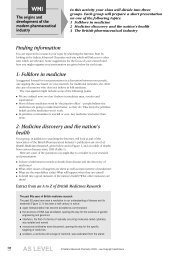
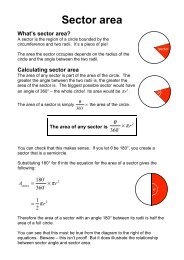
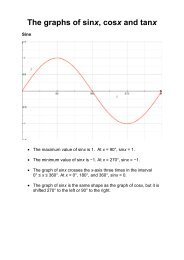
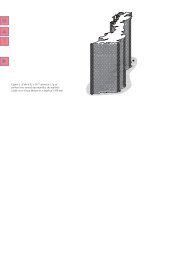

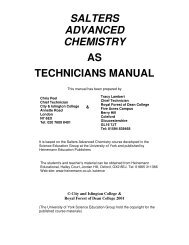


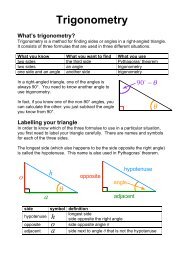
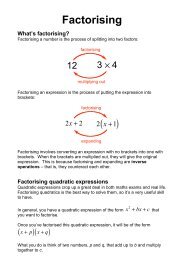
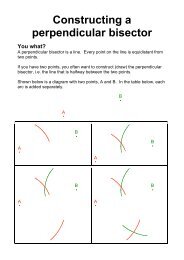

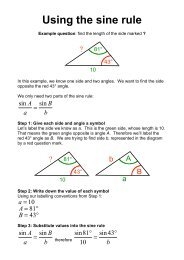
![ISI Web of Knowledge [v.4.10] - All Databases Results - Benjamin-Mills](https://img.yumpu.com/39253071/1/184x260/isi-web-of-knowledge-v410-all-databases-results-benjamin-mills.jpg?quality=85)